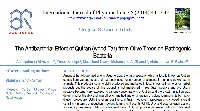The Antibacterial Effect of Qutran (wood Tar) from Olive Trees on Pathogenic Bacteria
Keywords:
Qutran, antibacterial effect, minimum bactericidal concentration, Gram positive, Gram negative bacteriaAbstract
Amongst the folklore medicine in Saudi Arabia, the tar preparation which is locally known as Qutran comes from various trees and has been used for a number of ailments in humans as well as in animals. This product is commercially produced and marketed in local shops selling herbs or herbal products but the source of this product is not mentioned. Three Gram positive and two Gram negative bacteria were exposed to various concentrations of Qutran and the growth inhibition was determined by the disk and agar diffusion method and enumeration of colony forming units by micro-dilution procedure. Both the Gram positive and Gram negative microorganisms showed a great sensitivity in terms of reduction in colony forming unit counts (CFU). Disk and agar diffusion assays showed a phenomenal inhibition of bacterial growth to Gram positive but lesser inhibition of bacterial growth in Gram negative bacteria. It was observed by the enumeration of CFU counts that the Qutran exerts more growth inhibition (killing effect) on Gram positive microorganisms than onto Gram negative bacteria. This effect could be taken as action on the mucopeptide content of Gram positive bacteria than its presence in the trilaminar cell walls of Gram negative bacteria. The minimal biocidal activity (MBC) of Qutran towards the Gram positive microorganisms tested was determined as ≤0.625mg/ml, while the Gram negative microorganisms showed no growth above 1.25mg/ml.
References
. Roelofzen JH, Aben KK, van der Valk
PG, van Houtum JL, van de Kerkhof
PC, Kiemeney LA. Coal tar in
dermatology. J Dermatologic
Treatment. 2007; 18:329-334.
. Chanthachum S and Beuchaf R.
Inhibitory effect of Kiam
(Cotylelobiumlanceotatumcriah) wood
extract on Gram positive food-borne
pathogens and spoilage
microorganisms. Food Microbiology.
; 14:603-608.
. Mohan D, Shi J, Nicholas DD, Pittman
CU Jr, Steele PH, Cooper JE.
Fungicidal values of bio-oils and their
lignin-rich fractions obtained from
wood/bark fast pyrolysis.
Chemosphere. 2006; 71:456-465.
. Kartal SN, Terzi E, Holmeyr J, Imamura
Y. Efficacy of tar oil recovered during
slow pyrolysis of macadamia nut shells.
International bio-deterioration and
Biodegradation. 2011; 65:369-373.
. Jonsson R. Separation and
identification of some naturally
occurring alkylphenanthrenes. Talanta.
; 15:425-431.
. Lopez D, Acelas N, Mondragon F.
Average structural analysis of tar
obtained from pyrolysis of wood.
Bioresour Technol. 2010; 101:2458-
. Siddiqui YM, Ettayebi M, Haddad AM,
Al-Ahdal MN. Effect of essential oils on
the enveloped viruses: antiviral activity
of oregano and clove oils on herpes
simplex virus type-I and Newcastle
disease virus. Med Sci Res. 1996;
:185-186.
. Minami M, Kita M, Nakayua T,
Yamamoto T, Kuriyama H, Imanishi J.
The inhibitory effect of essential oils on
Herpes simplex type-1 replication in
vitro. MicrobiolImmunol. 2003; 47:681-
. Vukovic N, Sukdolak S, Solujic S,
Niciforovic N. Antimicrobial activity of
the essential oil obtained from roots
and chemical composition of the
volatile constituents from the roots,
stems and leaves of balata nigra from
Serbia. J Medical Food. 2009; 12:435-
. Drew DL, Barry AL, O'Toole R, Sherris
JC. Reliability of the Kirby-Bauer disc
diffusion method for detecting
methicillin-resistant strains of
Staphylococcus aureus. Applied
Microbiology. 1972; 24:240-247.
. Barry AL and Brown SD. Fluconazole
disk diffusion procedure for determining
susceptibility of Candida species. J
ClinMicrobiol. 1996; 34:2154-2157.
. Brockow K, Grabenhorst P, Abeck D,
Traupe B, Ring J, Hoppe U, Wolf F.
Effect of gentian violet, corticosteroid
and tar preparations in
Staphylococcus-aureus-colonized
atopic eczema. Dermatology. 1999;
(3):231-236.
. Yang F-C, Wu K-H, Liu M-J, Lin W-P,
Hu M-K. Evaluation of the antibacterial
efficacy of bamboo charcoal/silver
biological protective material. Materials
Chemistry Physics. 2009; 113:474-479.
. Nenoff P, Haustein UF, Fiedler A., The
antifungal effect of a coal tar gel on
Malassezia furfur in vitro. Dermatology.
; 191:311-314.
. Kizil G, Yavuz M, Aytekin C.
Antimicrobial activity of the resins
obtained from the roots and stems of
Cedruslibaniand
Abiescilicica.PriklBiokhimMikrobiol.
; 38:166-168.
. Veijola V and Mustakallio E. The
bacteriostatic effect of the wood tar,
Ann Med ExpBiolFenn. 1963; 41:407-
. Merk HF, Mukhtar H, Kaufmann I, Das
M, Bickers DR. 1987. Human hair
follicle benzo [a] pyrene and benzo
[a]pyrene 7,8-diol metabolism: effect of
exposure to coal tar-containing
shampoo. J Invest Dermatology. 1987;
:71-76.
. Schmid MH and Korting HC. Coal tar,
pine tar and sulfonated shale oil
preparations: comparative activity,
efficacy and safety. Dermatology.
; 193:1-5.
. Faure P and Antognarelli C. Treatment
of Psoriasis with pine-tar, past and
present. Rev Hist Pharm. 1996;
:352-355.
. Stone OJ and Anthony JA. The effect
of tar on wound healing. Arch Environ
Health. 1970; 20:603-604.
. Rodríguez‐Tudela JL and Barchies F.
Method for the determination of
minimum inhibitory concentration (MIC)
by broth dilution of fermentative yeasts.
ClinMicrobiol. 2003; 9:1-8.
. Hsu DI, Hidayat LK, Quist R, Hindler J.
Comparison of method-specific
vancomycin minimum inhibitory
concentration values and their
predictability for treatment outcome of
methicillin-resistant Staphylococcus
aureus (MRSA) infections. Int J
AntimicrobAgents. 2008; 32:378-385.
. Athanasiou K and Lillis D. Absence of
mutagenic and clastogenicity action of
pine-tar resin in the
Salmonella/microsomal and CHO
culture systems. Mutation Research
; 103: 229-232.



